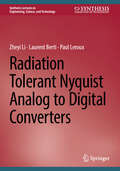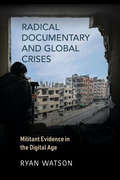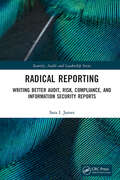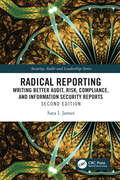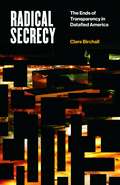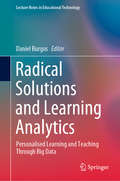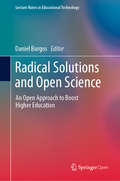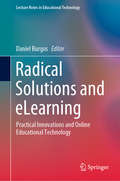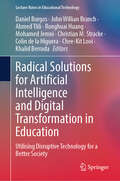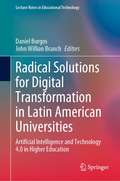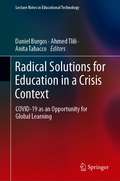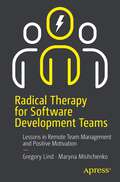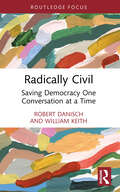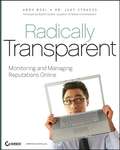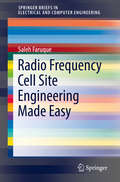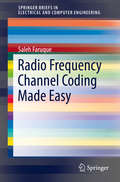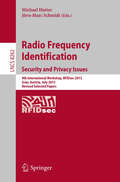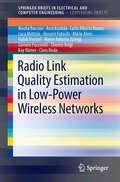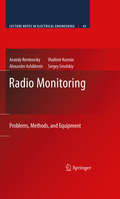- Table View
- List View
Radial Basis Function (RBF) Neural Network Control for Mechanical Systems
by Jinkun LiuRadial Basis Function (RBF) Neural Network Control for Mechanical Systems is motivated by the need for systematic design approaches to stable adaptive control system design using neural network approximation-based techniques. The main objectives of the book are to introduce the concrete design methods and MATLAB simulation of stable adaptive RBF neural control strategies. In this book, a broad range of implementable neural network control design methods for mechanical systems are presented, such as robot manipulators, inverted pendulums, single link flexible joint robots, motors, etc. Advanced neural network controller design methods and their stability analysis are explored. The book provides readers with the fundamentals of neural network control system design. This book is intended for the researchers in the fields of neural adaptive control, mechanical systems, Matlab simulation, engineering design, robotics and automation. Jinkun Liu is a professor at Beijing University of Aeronautics and Astronautics.
Radiation Tolerant Nyquist Analog to Digital Converters (Synthesis Lectures on Engineering, Science, and Technology)
by Paul Leroux Zheyi Li Laurent BertiThis book presents the detailed design considerations and techniques for radiation-tolerant (RT) Nyquist analog-to-digital converters (ADC). It begins with the fundamental radiation effects in space and its consequences in modern CMOS technology. Next, radiation effects on ADCs from the transistor level to the architectural level are examined and a detailed design tradeoffs and strategies for radiation-tolerant ADCs are described. The theory and hardening techniques are supported by measurement data from a high-performance RT-ADC prototype chip. Two important flows, which are a technology evaluation flow and an RT IC design flow, are also covered, in order to give a complete overview on how to achieve an effective RT circuits design.
Radical Documentary and Global Crises: Militant Evidence in the Digital Age
by Ryan WatsonWhen independent filmmakers, activists, and amateurs document the struggle for rights, representation, and revolution, they instrumentalize images by advocating for a particular outcome. Ryan Watson calls this "militant evidence."In Radical Documentary and Global Crises, Watson centers the discussion on extreme conflict, such as the Iraq War, the occupation of Palestine, the war in Syria, mass incarceration in the United States, and child soldier conscription in the Congo. Under these conditions, artists and activists aspire to document, archive, witness, and testify. The result is a set of practices that turn documentary media toward a commitment to feature and privilege the media made by the people living through the terror. This footage is then combined with new digitally archived images, stories, and testimonials to impact specific social and political situations. Radical Documentary and Global Crises re-orients definitions of what a documentary is, how it functions, how it circulates, and how its effect is measured, arguing that militant evidence has the power to expose, to amass, and to adjudicate.
Radical Reporting: Writing Better Audit, Risk, Compliance, and Information Security Reports (Security, Audit and Leadership Series)
by Sara I. JamesMost people dread writing reports; they also dread reading reports. What they don’t realize is that the techniques that make writing more readable make it more powerful. This is especially relevant for professionals in areas such as audit, risk, compliance, and information security. This small volume provides the tools and techniques needed to improve reports. It does so through addressing crucial concepts all too often overlooked in the familiar rush to perform tasks, complete projects, and meet deadlines. These concepts – the role of culture in communication; the link between logic and language; the importance of organizing thoughts before writing; and how to achieve clarity – may seem academic or theoretical. They’re not. Unless writers understand their own thoughts, actions, and objectives, they cannot hope to communicate them at all – let alone clearly.
Radical Reporting: Writing Better Audit, Risk, Compliance, and Information Security Reports (Security, Audit and Leadership Series)
by Sara I. James"If I were giving out an award for 'book of the year' for internal audit professionals, I would certainly award it to her outstanding manuscript: Radical Reporting: Writing Better Audit, Risk, Compliance and Information Security Reports." - Richard Chambers, Former President and CEO, The Institute of Internal AuditorsMost people dread writing reports; they also dread reading reports. What they don’t realize is that the techniques that make writing more readable make it more powerful. This is especially relevant for professionals in areas such as audit, risk, compliance, and information security.This small volume provides the tools and techniques needed to improve reports. It does so through addressing crucial concepts all too often overlooked in the familiar rush to perform tasks, complete projects, and meet deadlines.These concepts – the role of culture in communication; the link between logic and language; the importance of organizing thoughts before writing; and how to achieve clarity – may seem academic or theoretical. They’re not. Unless writers understand their own thoughts, actions, and objectives, they cannot hope to communicate them at all – let alone clearly.This second edition develops these points with additional material on critical thinking, as well as the use of AI in reporting.
Radical Secrecy: The Ends of Transparency in Datafied America (Electronic Mediations #60)
by Clare BirchallReimagining transparency and secrecy in the era of digital data When total data surveillance delimits agency and revelations of political wrongdoing fail to have consequences, is transparency the social panacea liberal democracies purport it to be? This book sets forth the provocative argument that progressive social goals would be better served by a radical form of secrecy, at least while state and corporate forces hold an asymmetrical advantage over the less powerful in data control. Clare Birchall asks: How might transparency actually serve agendas that are far from transparent? Can we imagine a secrecy that could act in the service of, rather than against, a progressive politics? To move beyond atomizing calls for privacy and to interrupt the perennial tension between state security and the public&’s right to know, Birchall adapts Édouard Glissant&’s thinking to propose a digital &“right to opacity.&” As a crucial element of radical secrecy, she argues, this would eventually give rise to a &“postsecret&” society, offering an understanding and experience of the political that is free from the false choice between secrecy and transparency. She grounds her arresting story in case studies including the varied presidential styles of George W. Bush, Barack Obama, and Donald Trump; the Snowden revelations; conspiracy theories espoused or endorsed by Trump; WikiLeaks and guerrilla transparency; and the opening of the state through data portals.Postsecrecy is the necessary condition for imagining, finally, an alternative vision of &“the good,&” of equality, as neither shaped by neoliberal incarnations of transparency nor undermined by secret state surveillance. Not least, postsecrecy reimagines collective resistance in the era of digital data.
Radical Solutions and Learning Analytics: Personalised Learning and Teaching Through Big Data (Lecture Notes in Educational Technology)
by Daniel BurgosLearning Analytics become the key for Personalised Learning and Teaching thanks to the storage, categorisation and smart retrieval of Big Data. Thousands of user data can be tracked online via Learning Management Systems, instant messaging channels, social networks and other ways of communication. Always with the explicit authorisation from the end user, being a student, a teacher, a manager or a persona in a different role, an instructional designer can design a way to produce a practical dashboard that helps him improve that very user’s performance, interaction, motivation or just grading. This book provides a thorough approach on how education, as such, from teaching to learning through management, is improved by a smart analysis of available data, making visible and useful behaviours, predictions and patterns that are hinder to the regular eye without the process of massive data.
Radical Solutions and Open Science: An Open Approach to Boost Higher Education (Lecture Notes in Educational Technology)
by Daniel BurgosThis open access book presents how Open Science is a powerful tool to boost Higher Education. The book introduces the reader into Open Access, Open Technology, Open Data, Open Research results, Open Licensing, Open Accreditation, Open Certification, Open Policy and, of course, Open Educational Resources. It brings all these key topics from major players in the field; experts that present the current state of the art and the forthcoming steps towards a useful and effective implementation. This book presents radical, transgenic solutions for recurrent and long-standing problems in Higher Education. Every chapter presents a clear view and a related solution to make Higher Education progress and implement tools and strategies to improve the user’s performance and learning experience. This book is part of a trilogy with companion volumes on Radical Solutions & Learning Analytics and Radical Solutions & eLearning.
Radical Solutions and eLearning: Practical Innovations and Online Educational Technology (Lecture Notes in Educational Technology)
by Daniel BurgosEducational Technology is the right couple to a radical innovation. Thanks to the appropriate technology in the right context with the best fit to the target audience, education can be drastically improved, meaning a better performance, competence achievement, match with the user’s expectations and with the market needs. Serious games, Virtual reality, Augmented reality, Remote labs, Online learning, Blockchain, Mobile learning and many other key technologies allow for a better explanation of so many subjects, and even more: for a complete student involvement and a full teacher engagement into the educational system. Technology gives another angle to the same content, provides the user with a personalised experience and pushes the limits of knowledge a little further, every time. This book presents a number of radical innovations through technology, from experienced cases studies, to be replicated and inspired by; a powerful resource handbook for cutting-edge education.
Radical Solutions for Artificial Intelligence and Digital Transformation in Education: Utilising Disruptive Technology for a Better Society (Lecture Notes in Educational Technology)
by Chee-Kit Looi Ronghuai Huang Mohamed Jemni Daniel Burgos Ahmed Tlili Christian M. Stracke John Willian Branch Khalid Berrada Colin de la HigueraThis book facilitates understanding of how artificial intelligence (AI) aids and integrates digital transformation (DT) in education institutions worldwide in various scenarios: learning environments (learning innovation, learning management systems, data and analytics), emerging education trends (business trends, strategic technologies), administrative systems (recruit, retain, advance, enterprise business capabilities, student information systems), and digital strategy execution (business models and opportunities, strategic planning and governance). It serves as a reference for university lecturers, schoolteachers, policymakers, and international organizations, who will find in its various chapters practical recommendations and discoveries from practice, ready to be implemented in their contexts. Chapters 1, 2, 7 and 9 are available open access under a Creative Commons Attribution 4.0 International License via link.springer.com.
Radical Solutions for Digital Transformation in Latin American Universities: Artificial Intelligence and Technology 4.0 in Higher Education (Lecture Notes in Educational Technology)
by Daniel Burgos John Willian BranchThis book presents how Digital Transformation is a requirement to upgrade Latin American universities to a next level in management, lecturing and learning processes and strategies. The book starts with a thorough introduction of the Latin American context addressing the three main topics in the book: Digital Transformation, Higher Education and Artificial Intelligence & Industry 4.0. They will be depicted by region, with a clear distribution between Central America & Mexico, Comunidad Andina (Perú, Colombia, Chile, Ecuador, Bolivia), Mercosur (Argentina, Brasil, Paraguay and Uruguay), and other countries. The book also shows how online learning is a key part of the transformation, with a clear focus on learning management systems, innovation and learning analytics. Further, personalised services for every single profile at the university (students, lecturers, academic managers) are presented to guarantee inclusive education service aggregation for networked campuses. Following, the book addresses strategy and overall services that concentrate on sustainability and revenue models integrated with a strategic planning. Finally a set of chapters will show specific experiences and case studies of direct application of Artificial Intelligence and Technology 4.0, where the readers can learn from and transfer directly into their educational contexts.
Radical Solutions for Education in Africa: Open Education and Self-directed Learning in the Continent (Lecture Notes in Educational Technology)
by Daniel Burgos Jako OlivierThis book explores the state of open education in terms of self-directed learning on the African continent. Through a combination of conceptual, systematic literature review and empirical chapters, readers will get a research-based impression of these aspects in this area. Apart from presenting existing wider trends regarding open education, this book also reports on effective open practices in support of self-directed learning.
Radical Solutions for Education in a Crisis Context: COVID-19 as an Opportunity for Global Learning (Lecture Notes in Educational Technology)
by Anita Tabacco Daniel Burgos Ahmed TliliThis book presents how to keep working on education in contexts of crisis, such as emergencies, zones of conflict, wars and health pandemics such as COVID-19. Specifically, this work shows a number of strategies to support global learning and teaching in online settings. Particularly, it first presents how to facilitate knowledge sharing and raising awareness about a specific crisis, to increase people’s safety, including educators and learners. The book then discusses various techniques, mechanisms and services that could be implemented to provide effective learning support for learners, especially in learning environments that they do not daily use, such as physical classrooms. Further, the work presents how to teach and support online educators, no matter if they are school teachers, university lecturers, youth social workers, vocational training facilitators or of any other kind. Finally, it describes worldwide case studies that have applied practical steps to keep education running during a crisis.This book provides readers with insights and guidelines on how to maintain learning undisrupted during contexts of crisis. It also provides basic and practical recommendations to the various stakeholders in educational contexts (students, content providers, technology services, policy makers, school teachers, university lecturers, academic managers, and others) about flexible, personalised and effective education in the context of crisis.
Radical Solutions in Palestinian Higher Education: Research from An-Najah National University (Lecture Notes in Educational Technology)
by Daniel Burgos Saida AffounehThis book brings together education research and practice carried out by An-Najah National University, a lead Higher Institution in Palestine that managed to move from a face-to-face setting to a fully online learning and teaching environment during the initial COVID-19 outbreak, within a month, seamlessly, which makes a success cases study of virtualization. This book concentrates on approaches to ensure the continuous improvement and quality of higher education provision across the country, with particular focus on: a) learning and teaching methodologies in online settings; b) use of open education as a key resource; and c) development of academic capability building, along with academic and knowledge exchange with other higher education partners. Innovative ideas, best practices, and comparative case studies are presented, discussed, and compared with international ones to make specific recommendations for a successful and sustainable implementation.
Radical Therapy for Software Development Teams: Lessons in Remote Team Management and Positive Motivation
by Gregory Lind Maryna MishchenkoBuild and maintain effective, collaborative, and motivated software development teams. This book addresses the challenges in doing so, like communication gaps, trust issues, and motivation problems, and provides strategies to overcome them. You'll be introduced to the Radical Therapy Dev philosophy, a holistic approach designed to optimize software development teams for better performance and overall well-being. This book highlights common pain points in software development and offers solutions to resolving much of the issues in teams. It offers strategies for implementation, focusing on adaptability and accountability, while also promoting community-supported standards. And, the book reveals why an emphasis on fostering a growth mindset, mentorship programs, and junior-intern initiatives promotes continuous learning and collaboration.With the rise of remote work, you'll see why hiring globally while thinking locally is gaining popularity. You'll also gain insights into removing barriers to remote work, along with tools and policies for remote collaboration. Additionally, the book explores the concept of cloud-native software development and its benefits. Radical Therapy for Software Development Teams critiques the traditional "agile" methodology, identifying its shortcomings while extracting valuable lessons that can still be applied effectively. What You Will LearnAddress communication gaps, foster trust, and nurture a growth mindset among team membersAvoid common feedback mistakes, recognize accomplishments, and implement a reward systemImprove software development practices and team dynamics Take a scientific approach to project management rather than traditional requirements gatheringBreak Down Communication BarriersWho This Book is ForSoftware development professionals
Radically Civil: Saving Democracy One Conversation at a Time (Routledge Research in Political Communication)
by William Keith Robert DanischIf you feel like the world has gone to hell in a handbasket, you’re not alone. If you often feel there’s nothing you can do about it, you’re also not alone. Along with this increasing anger, fear, and frustration, much confusion still prevails on the appropriate communication practices for responding to difficult situations and improving our lives. Communication experts, Robert Danisch and William Keith, explain why and how we can practice radical civility in this practical guide to everyday “political” communication. This guide begins with examples of radical civility to show the potential of this kind of communication to change minds and bridge differences. The authors then unpack the three foundational principles of radical civility as useful theoretical tools for thinking throughout interactions with others in civic spaces. This is then followed by a three-step process for practicing radical civility drawing on research into active listening and its importance for creating connections, validating other views, and opening up possibilities for future conversation. The guide concludes with evidence-based communication practices and prescriptive recommendations for how to do each and show examples of each in action. Radically Civil: Saving Democracy One Conversation at a Time is a much-needed communication-based antidote to polarization, preparing students, researchers, and community leaders to be responsible participants in today’s society.
Radically Transparent
by Andy Beal Judy StraussThe explosion of social media blogs, social networking sites, and video sharing sites has ushered in a new era of digital transparency that puts the power to enhance or destroy a reputation in the hands of the consumer. This timely and practical book shows you how to harness the power of social media with crucial, proven tactics and strategies for every phase of online reputation management. Using step-by-step instruction and tested techniques, the expert authors unveil a detailed blueprint for building, managing, monitoring, and repairing your reputation.
Radio Frequency Cell Site Engineering Made Easy (SpringerBriefs in Electrical and Computer Engineering)
by Saleh FaruqueThis book introduces Radio Frequency Cell Site Engineering to a broad audience. The author blends theory and practice to bring readers up-to-date in key concepts, underlying principles and practical applications of wireless communications. The presentation is designed to be easily accessible, minimizing mathematics and maximizing visuals.
Radio Frequency Channel Coding Made Easy
by Saleh FaruqueThis book introduces Radio Frequency Channel Coding to a broad audience. The author blends theory and practice to bring readers up-to-date in key concepts, underlying principles and practical applications of wireless communications. The presentation is designed to be easily accessible, minimizing mathematics and maximizing visuals.
Radio Frequency Identification
by Michael Hutter Jörn-Marc SchmidtThis book constitutes the proceedings of the 9th Workshop on RFID Security and Privacy, RFIDsec 2013, held in Graz, Austria, in July 2013. The 11 papers presented in this volume were carefully reviewed and selected from 23 submissions. RFIDsec deals with topics of importance to improving the security and privacy of RFID, NFC, contactless technologies, and the Internet of Things. RFIDsec bridges the gap between cryptographic researchers and RFID developers.
Radio Frequency Integrated Circuit Design for Cognitive Radio Systems
by Amr FahimThis book fills an information gap on cognitive radios, since the discussion focuses on the implementation issues that are unique to cognitive radios and how to solve them at both the architecture and circuit levels. This is the first book to describe in detail cognitive radio systems, as well as the circuit implementation and architectures required to implement such systems. Throughout the book, requirements and constraints imposed by cognitive radio systems are emphasized when discussing the circuit implementation details. This is a valuable reference for anybody with background in analog and radio frequency (RF) integrated circuit design, needing to learn more about integrated circuits requirements and implementation for cognitive radio systems.
Radio Frequency Multiple Access Techniques Made Easy (SpringerBriefs in Electrical and Computer Engineering)
by Saleh FaruqueThis book provides a comprehensive overview of multiple access techniques used in the cellular industry. The usage of multiple access techniques in telecommunications enables many users to share the same spectrum in the frequency domain, time domain, code domain or phase domain. Licenses are given, by the FCC, to operate wireless communication systems over given bands of frequencies, with the smaller bands, (channels), reused to provide services to other users. Thus, bandwidth efficiency is vital, as the speed and size of digital data networks continue to expand. This brief also uses numerous illustrations to bring students up-to-date in the practical applications of multiple access techniques, which can then be put to work in the industry. Primarily, electrical engineering students who study telecommunications, as well as engineers and designers working in wireless communications, would find this book useful.
Radio Interfaces in the Internet of Things Systems: Performance studies
by Kamil StaniecThe book gives a broad overview of the Internet of Things (IoT) concept from various angles. The book provides rationale for: the concept development; its regulatory and technical background associated aspects such as the ambient and edge intelligence; fog computing; capillary networks and machine-type communications; etc. Each of these items is then extended in further respective chapters that deal with technicalities behind them. Chapters: 2-5, 8, 10-11 are addressed to those who seek expository IoT-related information on aspects such as the pathloss calculation, narrowband radio interfaces, radiation masks, spectrum matters, medium access control, and a transmission frame construction. That section ends with an exhaustive description of the six most popular IoT systems: LoRa, Weightless, SigFox, NB-IoT, LTE-M(TC) and EC-GSM IoT. Specialists and network designers may find chapters 6 and 7 interesting where a novel methodology is proposed for testing narrowband IoT systems performance for immunity to electromagnetic interference (EMI) and multipath propagation, both emulated in artificial conditions of the anechoic and the reverberation chamber.
Radio Link Quality Estimation in Low-Power Wireless Networks
by Marco Antonio Zuniga Carlo Alberto Boano Claro Noda Luca Mottola Habib Youssef Hossein Fotouhi Daniele Puccinelli Anis Koubâa Kay Römer Mário Alves Nouha Baccour Thiemo VoigtThis book provides a comprehensive survey on related work for radio link quality estimation, which covers the characteristics of low-power links, the fundamental concepts of link quality estimation in wireless sensor networks, a taxonomy of existing link quality estimators and their performance analysis. It then shows how link quality estimation can be used for designing protocols and mechanisms such as routing and hand-off. The final part is dedicated to radio interference estimation, generation and mitigation.
Radio Monitoring
by Alexander Ashikhmin Vladimir Kozmin Sergey M. Smolskiy Anatoly RembovskyRadio Monitoring: Problems, Methods, and Equipment offers a unified approach to fundamental aspects of Automated Radio Monitoring (ARM). The authors discuss the development, modeling, design, and manufacture of ARM systems. Data from established and recent research are presented and recommendations are made on methods and approaches for solving common problems in ARM. The authors also provide classification and detailed descriptions of modern high-efficient hardware-software ARM equipment, including the equipment for detection, radio direction-finding, parameters measurement and their analysis, and the identification and localization of the electromagnetic field sources. Examples of ARM equipment structure, applications, and software are provided to manage a variety of complicated interference environment in the industrial centers, inside of the buildings, and in the open terrain. This book provides a reference for professionals and researchers interested in deploying ARM technology as a tool for solving problems from radio frequency spectrum usage control.

